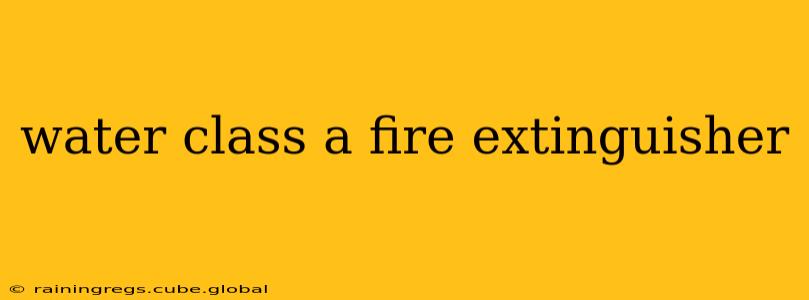Water is a readily available and effective extinguishing agent for many common fires, making Class A fire extinguishers a vital part of any fire safety plan. But understanding their capabilities, limitations, and proper usage is crucial for ensuring safety and preventing further damage. This guide will provide comprehensive information on water Class A fire extinguishers, addressing common questions and concerns.
What is a Class A Fire Extinguisher?
A Class A fire extinguisher is designed to combat Class A fires, which involve ordinary combustible materials like wood, paper, cloth, rubber, and many plastics. These materials burn readily and leave behind ashes. Water is an effective suppressant for Class A fires because it cools the burning material below its ignition temperature, interrupting the combustion process. Water Class A extinguishers typically use pressurized water to extinguish the flames.
How Does a Water Class A Fire Extinguisher Work?
The extinguisher uses pressurized water, often propelled by compressed air or nitrogen, to create a powerful jet or spray that directly targets the base of the flames. The water cools the burning material, effectively suppressing the fire. The effectiveness of water relies on its ability to absorb heat and prevent reignition.
What are the Limitations of Water Class A Fire Extinguishers?
While highly effective against Class A fires, water Class A extinguishers are not suitable for all fire types. Crucially, never use a water extinguisher on Class B (flammable liquids) or Class C (energized electrical) fires. Water can spread flammable liquids and may cause electrocution when used on electrical fires.
Can I use a water extinguisher on a grease fire?
No. Water added to a grease fire will cause the burning grease to splatter violently, potentially spreading the fire and causing serious injury. Grease fires require specialized extinguishing agents, like Class B or K fire extinguishers.
Can I use a water extinguisher on an electrical fire?
No. Water conducts electricity, and using a water extinguisher on an energized electrical fire can lead to electrocution. Always disconnect the power source before attempting to extinguish an electrical fire. Use a Class C fire extinguisher designed for electrical fires.
What type of water is used in Class A fire extinguishers?
Most Class A fire extinguishers use plain water, sometimes with additives to improve its extinguishing properties or prevent freezing. However, the exact composition may vary depending on the manufacturer and specific design of the extinguisher.
How to choose the right size water extinguisher?
The appropriate size of a water extinguisher depends on the size of the area being protected and the potential fire hazards present. Larger areas and greater potential for significant fires will require larger extinguishers. Refer to relevant fire safety regulations and guidelines for recommendations on the appropriate extinguisher size for your specific needs.
How often should I get my water extinguisher serviced?
Regular servicing is essential to ensure the extinguisher is in working order. The frequency of servicing will depend on the local regulations and the type of extinguisher, but typically it’s recommended to have them inspected annually by a qualified technician. Any extinguisher that shows signs of damage or malfunction should be serviced immediately.
This information is for educational purposes only and should not replace professional fire safety training. Always consult with fire safety professionals for specific guidance on your fire safety needs. Knowing how to properly use a fire extinguisher can save lives and property. Remember to always prioritize your safety and evacuate the area if the fire is too large or beyond your ability to control.
